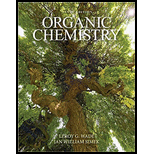
ORGANIC CHEMISTRY
9th Edition
ISBN: 9780134645704
Author: WADE AND SIMEK
Publisher: PEARSON
expand_more
expand_more
format_list_bulleted
Concept explainers
Question
Chapter 26.2B, Problem 26.5P
Interpretation Introduction
Interpretation: The monomer which polymerizes well on treatment with
Concept Introduction: The monomer which contains electron donating substituent in its structure can polymerize well in the presence of
To determine: The monomer which polymerizes well with
Expert Solution & Answer
Want to see the full answer?
Check out a sample textbook solution
Students have asked these similar questions
4. Provide a clear arrow-pushing mechanism for each of the following reactions. Do not skip proton
transfers, do not combine steps, and make sure your arrows are clear enough to be interpreted
without ambiguity.
a.
2.
1. LDA
3. H3O+
HO
b.
H3C CH3
H3O+
✓ H
OH
2. Provide reagents/conditions to accomplish the following syntheses. More than one step is
required in some cases.
a.
CH3
Chapter 26 Solutions
ORGANIC CHEMISTRY
Ch. 26.2A - Show the intermediate that would result if the...Ch. 26.2A - Prob. 26.2PCh. 26.2A - Prob. 26.3PCh. 26.2B - Prob. 26.4PCh. 26.2B - Prob. 26.5PCh. 26.2B - Chain branching occurs in cationic polymerization...Ch. 26.2C - Prob. 26.7PCh. 26.2C - Prob. 26.8PCh. 26.2C - Chain branching is not as common with anionic...Ch. 26.3 - Prob. 26.10P
Ch. 26.5 - Prob. 26.11PCh. 26.6 - Prob. 26.12PCh. 26.7A - Prob. 26.13PCh. 26.7B - Prob. 26.14PCh. 26.7B - Prob. 26.15PCh. 26.7C - a. Propose a mechanism for the reaction of...Ch. 26.7C - Prob. 26.17PCh. 26.7D - Prob. 26.18PCh. 26.7D - Prob. 26.19PCh. 26.7D - Prob. 26.20PCh. 26 - Prob. 26.21SPCh. 26 - Prob. 26.22SPCh. 26 - Poly(trimethylene carbamate) is used in...Ch. 26 - Prob. 26.24SPCh. 26 - Urylon fibers are used in premium fishing nets...Ch. 26 - Prob. 26.26SPCh. 26 - Prob. 26.27SPCh. 26 - Polyoxymethylene (polyformaldehyde) is the tough,...Ch. 26 - Prob. 26.29SPCh. 26 - Prob. 26.30SPCh. 26 - Prob. 26.31SPCh. 26 - Prob. 26.32SPCh. 26 - Prob. 26.33SPCh. 26 - Prob. 26.34SPCh. 26 - The polyester named Lactomer is an alternating...Ch. 26 - Prob. 26.36SP
Knowledge Booster
Learn more about
Need a deep-dive on the concept behind this application? Look no further. Learn more about this topic, chemistry and related others by exploring similar questions and additional content below.Similar questions
- Identify and provide an explanation that distinguishes a qualitative and quantitative chemical analysis. Provide examples.arrow_forwardIdentify and provide an explanation of the operational principles behind a Atomic Absorption Spectrometer (AAS). List the steps involved.arrow_forwardInstructions: Complete the questions in the space provided. Show all your work 1. You are trying to determine the rate law expression for a reaction that you are completing at 25°C. You measure the initial reaction rate and the starting concentrations of the reactions for 4 trials. BrO³¯ (aq) + 5Br¯ (aq) + 6H* (aq) → 3Br₂ (l) + 3H2O (l) Initial rate Trial [BrO3] [H*] [Br] (mol/L) (mol/L) | (mol/L) (mol/L.s) 1 0.10 0.10 0.10 8.0 2 0.20 0.10 0.10 16 3 0.10 0.20 0.10 16 4 0.10 0.10 0.20 32 a. Based on the above data what is the rate law expression? b. Solve for the value of k (make sure to include proper units) 2. The proposed reaction mechanism is as follows: i. ii. BrО¸¯ (aq) + H+ (aq) → HBrO3 (aq) HBrO³ (aq) + H* (aq) → H₂BrO3* (aq) iii. H₂BrO³* (aq) + Br¯ (aq) → Br₂O₂ (aq) + H2O (l) [Fast] [Medium] [Slow] iv. Br₂O₂ (aq) + 4H*(aq) + 4Br(aq) → 3Br₂ (l) + H2O (l) [Fast] Evaluate the validity of this proposed reaction. Justify your answer.arrow_forward
- a. H3C CH3 H, 1.0 equiv. Br2arrow_forwardH3C. H3C CH 3 CH 3 CH3 1. LDA 2. PhSeCl 3. H2O2arrow_forwardPlease predict the products for each of the following reactions: 1.03 2. H₂O NaNH, 1. n-BuLi 2. Mel A H₂ 10 9 0 H2SO4, H₂O HgSO4 Pd or Pt (catalyst) B 9 2 n-BuLi ♡ D2 (deuterium) Lindlar's Catalyst 1. NaNH2 2. EtBr Na, ND3 (deuterium) 2. H₂O2, NaOH 1. (Sia)2BH с Darrow_forward
- in the scope of ontario SCH4U grade 12 course, please show ALL workarrow_forwardIs the chemical reaction CuCl42-(green) + 4H2O <==> Cu(H2O)42+(blue) + 4Cl- exothermic or endothermic?arrow_forwardIf we react tetraethoxypropane with hydrazine, what is the product obtained (explain its formula). State the reason why the corresponding dialdehyde is not used.arrow_forward
arrow_back_ios
SEE MORE QUESTIONS
arrow_forward_ios
Recommended textbooks for you
 Organic ChemistryChemistryISBN:9781305580350Author:William H. Brown, Brent L. Iverson, Eric Anslyn, Christopher S. FootePublisher:Cengage Learning
Organic ChemistryChemistryISBN:9781305580350Author:William H. Brown, Brent L. Iverson, Eric Anslyn, Christopher S. FootePublisher:Cengage Learning

Organic Chemistry
Chemistry
ISBN:9781305580350
Author:William H. Brown, Brent L. Iverson, Eric Anslyn, Christopher S. Foote
Publisher:Cengage Learning